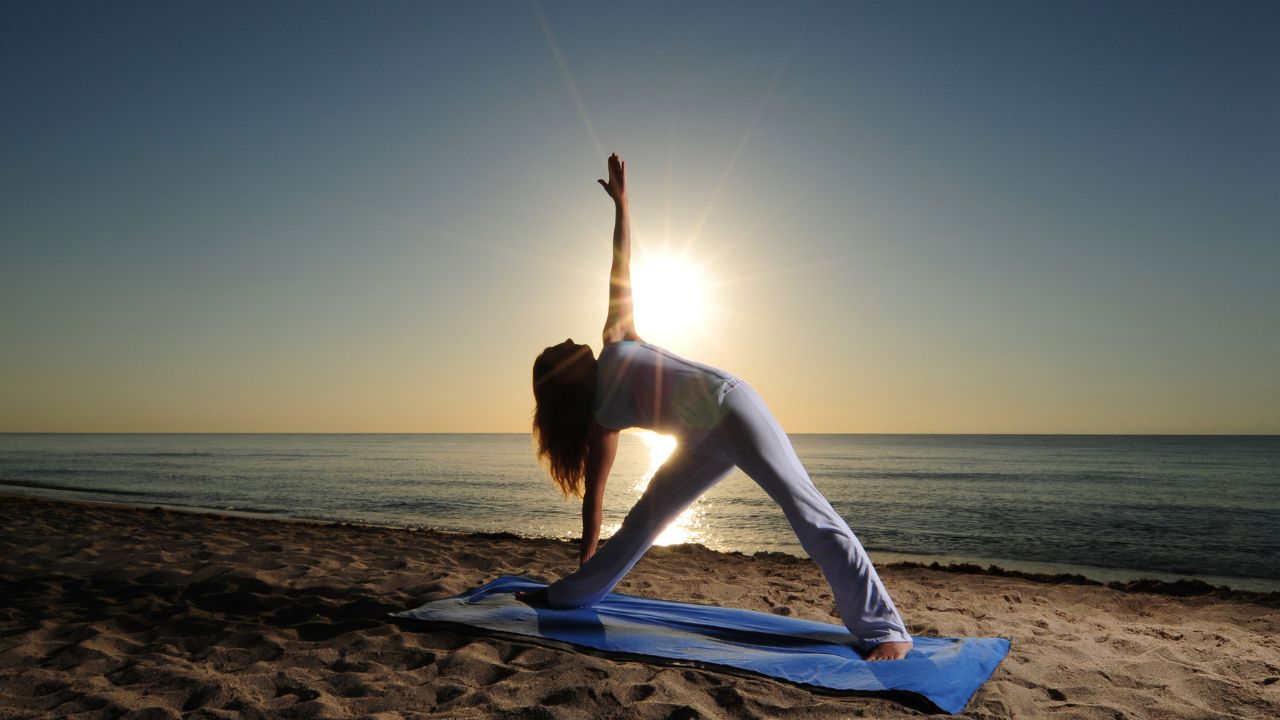Revolved Triangle Pose (Parivrtta Trikonasana)

Revolved Triangle Pose, or Parivrtta Trikonasana, is a standing twist that stretches the hamstrings, hips, and shoulders while improving spinal mobility and balance. It is an intermediate yoga pose that combines the benefits of Triangle Pose (Trikonasana) with a twist. Here’s how to practice Revolved Triangle Pose:
- Start in a standing position at the top of your mat with your feet hip-width apart. Take a moment to ground yourself and find stability.
- Step your left foot back, keeping your feet about three to four feet apart. Your right foot should be pointing forward, and your left foot should be turned out at a 45-degree angle.
- Square your hips to the front of the mat by rotating your left hip forward. Align your heels and extend your arms out to the sides at shoulder height.
- As you exhale, hinge forward from your hips, reaching your right hand towards the floor or a block on the outside of your right foot. Keep your spine long and extend your left arm up towards the ceiling, aligning it with your shoulders.
- Rotate your torso to the right, stacking your shoulders on top of each other. Imagine your spine being a straight line from your tailbone to the crown of your head.
- If you have the flexibility, you can deepen the twist by bringing your left arm across your body and hooking it on the outside of your right thigh. Press your palms together in a prayer position, or keep your left hand on your lower back for support.
- Keep your legs engaged by pressing through the outer edge of your back foot and lifting your inner arches. Maintain a steady breath and find a comfortable twist, avoiding any strain or discomfort.
- Hold the pose for several breaths, allowing your body to find stability and openness. Keep your gaze either forward or up towards your left hand, depending on your comfort and neck flexibility.
- To release the pose, slowly unwind the twist, returning your left hand to the mat or block and extending your right arm up. Inhale as you lift your torso back to an upright position, and step your left foot forward to meet your right foot. Repeat the pose on the other side.
Some key points to remember while practicing Revolved Triangle Pose:
- Maintain a strong foundation by grounding through your feet and engaging your leg muscles.
- Focus on lengthening your spine and creating space between your vertebrae as you twist.
- Use a block or prop if needed to bring the floor closer to your hand in the forward fold.
- Avoid collapsing your chest or rounding your shoulders. Keep your chest open and your shoulders relaxed.
Benefits of Revolved Triangle Pose include:
- Stretches and strengthens the legs, hips, hamstrings, and shoulders.
- Improves spinal mobility and increases rotational flexibility.
- Stimulates digestion and massages the abdominal organs.
- Builds core strength and stability.
- Enhances balance and concentration.
As with any yoga pose, it’s important to practice Revolved Triangle Pose with mindfulness and respect for your body’s limitations. If you have any specific concerns or limitations, it’s advisable to consult with a qualified yoga teacher for guidance. Enjoy the energizing and twisting benefits of Revolved Triangle Pose.
Specific Content Keywords : parivrtta trikonasana benefits,revolved triangle pose parivrtta trikonasana steps,revolved triangle pose parivrtta trikonasana benefits,revolved triangle pose parivrtta trikonasana meaning,viparita trikonasana,parivrtta trikonasana contraindications,parivrtta trikonasana meaning,parivrtta trikonasana steps,revolved triangle pose (parivrtta trikonasana),revolved triangle pose benefits,difference between trikonasana and parivrtta trikonasana,difference between trikonasana and utthita trikonasana,how to pronounce parivrtta trikonasana,how to do parivrtta trikonasana.

